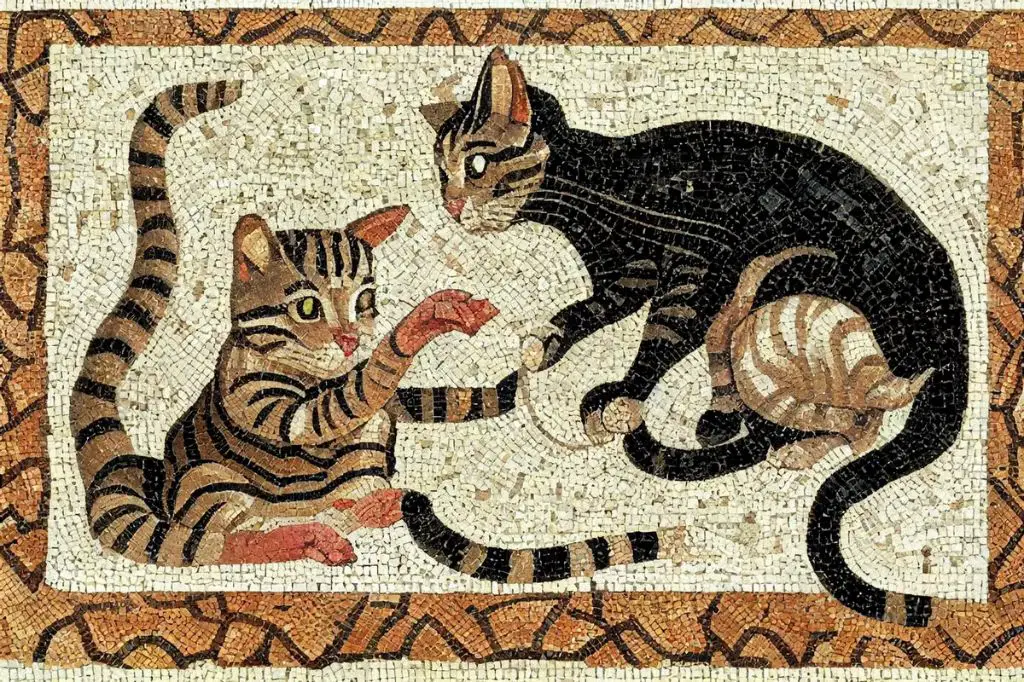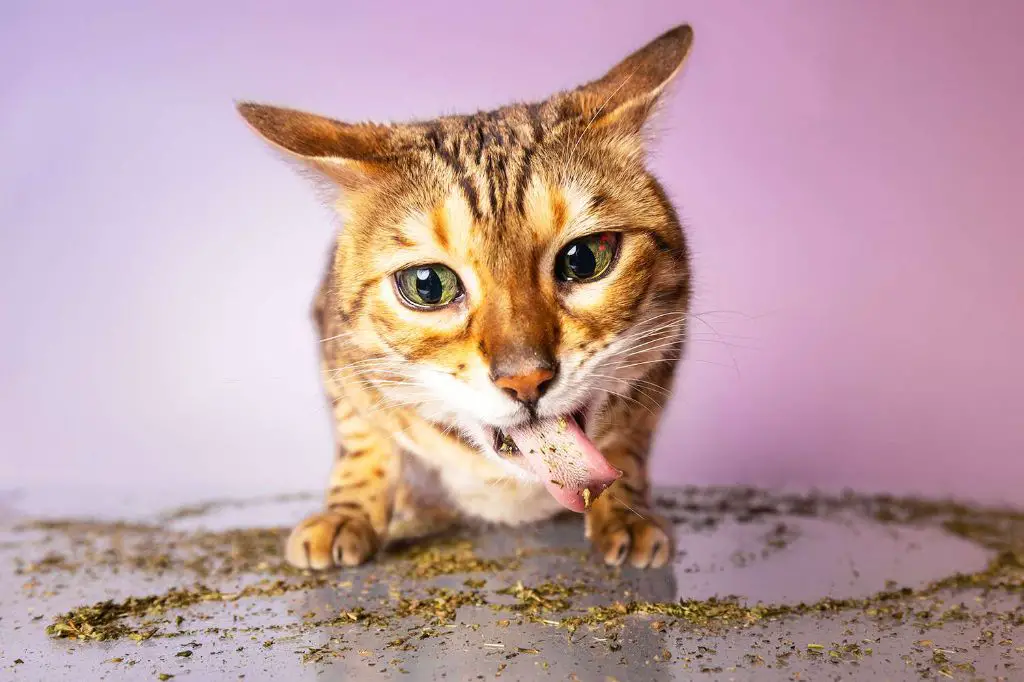Catnip (Nepeta cataria) is a type of mint native to regions of Europe and Asia. It contains nepetalactone, a chemical that mimics feline pheromones and induces a euphoric reaction when smelled by cats. Catnip elicits a stimulant response in cats, causing behaviors like rolling, flipping, rubbing, and self-grooming. Catnip does not actually have hallucinogenic properties, but the chemical triggers receptors that make cats feel good. Though best known for its effects on cats, some people also ingest catnip for its mild sedative effects. This article will explore why some humans use catnip and the benefits and risks of doing so.
[https://www.realclearscience.com/blog/2012/10/how_does_catnip_affect_humans.html](https://www.realclearscience.com/blog/2012/10/how_does_catnip_affect_humans.html)
History of Catnip Use

Catnip has a long history of use dating back thousands of years. The plant is native to parts of Europe and Asia, including the Mediterranean region and Nepal specifically. Catnip has been used medicinally since at least the Roman Empire. The Ancient Roman city of Nepeta was renowned for growing catnip and using it in cooking as well as medicine (Source). Many Ancient Romans also grew catnip in their home herb gardens.
In medieval times, catnip continued to be widely used for its medicinal properties. People used catnip to treat a variety of ailments including relieving stomach cramps, treating colds and fevers, and reducing anxiety and nervousness. Catnip was also commonly used as a culinary herb in medieval cuisine, adding flavor to stews, soups, and salads. The use of catnip both medicinally and culinarily expanded as its popularity spread across Europe and Asia (Source).
Catnip has had a long history of use by humans spanning thousands of years and across multiple cultures and civilizations. Its versatility as both a medicinal herb and culinary ingredient has contributed to its enduring popularity through the centuries.
Chemical Composition
The psychoactive properties of catnip are primarily due to a terpenoid called nepetalactone. According to a 2012 study published in Pharmaceutical Biology, nepetalactone is the major chemical constituent of catnip, making up 55–58% of the essential oil from the plant. There are two isomers of nepetalactone: 4a-α,7-α,7a-β-nepetalactone and 4a-α,7-β,7a-α-nepetalactone. These two isomers together account for 88-90% of the essential oil composition of catnip (Zomorodian, 2012).
Nepetalactone is structurally similar to some cannabinoids found in cannabis, like THC and CBD. However, the effects of nepetalactone on the human body differ significantly from those of cannabinoids. While THC intoxication can cause sedation, euphoria, increased appetite, and anxiety reduction, nepetalactone consumption mainly leads to mild sedative effects. The differences in physiological response are likely due to the binding of these compounds to different receptor sites in the brain and body.
Effects on the Brain
Catnip contains a chemical called nepetalactone which binds to olfactory receptors in a cat’s nose and has psychoactive effects on their brain. When cats smell or consume catnip, the nepetalactone molecule binds to receptors in the olfactory bulb, which transmits signals to the amygdala and hypothalamus regions of the brain.

This interaction triggers a response that releases dopamine, a neurotransmitter involved in pleasure and reward pathways in the brain. Dopamine produces feelings of euphoria and relaxation in cats.[1] Catnip also causes the release of serotonin which contributes to the mellow mood.
Additionally, catnip activates opioid receptors involved in pain, pleasure, and arousal. The combined effect of this neurochemical activity induces the characteristic playful, euphoric state that cats experience upon exposure to catnip.
Physiological Effects
When ingested, catnip can have several physiological effects on the body. The main active chemical in catnip, nepetalactone, acts as a mild sedative. It can relax muscles, lower blood pressure, and reduce anxiety and stress.
Catnip has been used in folk medicine as a natural sleep aid. The soothing, relaxing effects from catnip can help promote calmness and sleep. According to the Healthline article, catnip can produce a sedative effect that is “similar to chamomile or passionflower.”
Catnip may also have pain-relieving properties. Some research indicates that catnip exhibits analgesic effects. The sedative qualities of catnip may contribute to an overall sensation of pain relief.
Additionally, some claim that catnip can act as an aphrodisiac. The relaxing effects may reduce inhibitions. However, more research is needed on catnip’s effects on libido.
While catnip can produce relaxation and sedation, overconsumption may cause lethargy or sluggishness. Dizziness or vomiting can also occur in rare cases of toxicity.

Psychological Effects
Catnip has well-known euphoric effects on cats. The active chemical nepetalactone binds to receptors in a cat’s brain that trigger a euphoric feeling not unlike the high humans feel from opioids or cannabinoids, according to some experts. This produces a temporary happy and relaxed psychological state in the cat.
In addition to a positive mood shift, some cats may also experience mild hallucinogenic effects from catnip. They may stare at walls, “trip out”, or chase unseen objects. These hallucinations are temporary and part of the catnip experience.
However, the ecstatic response to catnip varies greatly between individual cats. Not all cats are affected by it strongly. The behavioral response typically lasts 5-15 minutes before subsiding.
Benefits and Risks
Catnip has demonstrated several potential health benefits when consumed by humans, though more research is still needed. According to WebMD, catnip tea has traditionally been used to treat restlessness, nervousness, coughs, asthma, gas, and diarrhea. Some initial research also indicates catnip may have anti-inflammatory, antioxidant, and antimicrobial properties.
However, the risks and side effects of regular catnip consumption have not been well studied. According to WebMD, catnip is likely safe for most adults in small amounts, though drinking cupfuls of catnip tea could potentially lead to side effects. Reported side effects include headaches, vomiting, and dizziness. Catnip can also act as a stimulant and sedative, so it is best to use with caution until more research determines safe dosages for humans.
Overall, catnip shows promise as a therapeutic herb but should be consumed carefully under the guidance of a health professional. More research is still needed to fully understand the benefits and risks before regular consumption can be recommended.

Forms Consumed
Catnip can be consumed by humans in various forms, with the most common being catnip tea, smoking, essential oils, and capsules.
Catnip tea is often touted as a relaxing and sedative drink. The tea is made by steeping dried catnip leaves and flowers in hot water for 5-10 minutes. Many claim the tea can aid sleep, reduce anxiety, and calm restlessness (1). However, no scientific studies have conclusively proven the benefits of catnip tea for humans.
Some people smoke catnip in a pipe or by rolling it into cigarettes as a marijuana substitute. The smoking method allows the catnip chemicals nepetalactone and nepetalic acid to enter the lungs and bloodstream rapidly. However, smoking catnip carries risks like lung irritation and offers unpredictable effects (2).
Catnip essential oil is also used by some looking for the plant’s sedative properties. The concentrated oil is usually diluted and applied on the skin or diffused into the air. But undiluted catnip oil can cause skin reactions in some people.
Finally, catnip can be taken in capsule form. But there is little evidence on the appropriate dosing, efficacy or safety profile of catnip supplements.
In summary, catnip is most often consumed as a tea, by smoking, as an essential oil, or in capsules. But human research on catnip is limited and more studies are needed to fully understand its effects and safety.
(1) https://www.allrecipes.com/article/what-is-catnip/
(2) https://www.healthline.com/health/smoking-catnip
Reasons for Use
Catnip has been used by humans for various recreational, medicinal, and spiritual purposes. Recreationally, some people smoke or ingest catnip for its mild euphoric effects. The chemical nepetalactone in catnip binds to cannabinoid receptors in the brain, producing a calming sensation similar to marijuana (Source: https://www.healthline.com/health/smoking-catnip). Some people use catnip recreationally as a cannabis substitute or for its lightheaded sensation.
Medicinally, catnip has been used to treat anxiety, insomnia, headaches, and gastrointestinal issues. Many people drink catnip tea to promote relaxation and sleep. According to some studies, catnip extract shows anti-inflammatory effects as well as sedative properties that induce drowsiness (Source: https://www.allrecipes.com/article/what-is-catnip/).
Spiritually, some practitioners use catnip in rituals, spells, or incense to enhance meditation. Some believe catnip can open up psychic abilities when smoked or drunk as a tea. The sedative effects of catnip may produce a calm, trance-like state that some view as spiritual.
Conclusion
In summary, catnip continues to be commonly used by some people for its mild stimulating and relaxing effects. This mint plant has a chemical compound called nepetalactone, which is known to cause a high in cats. When people consume catnip in various forms like tea and smoke, it can have an effect of gentle euphoria and calmness without any significant side effects of addiction or toxicity. However, the full mechanism of how catnip impacts the human brain and body requires more study.
While catnip and catnip products are generally considered harmless, each person should evaluate any potential risks and benefits for themselves before deciding to use it. Some may prefer safer herbal alternatives for relaxation. When used appropriately in moderation by people who enjoy its effects, catnip use can potentially provide a light recreational high, induce sleepiness, reduce anxiety, and create an overall sense of calm contentment.
In the end, the enjoyment of catnip’s effects or the cultural significance of catnip consumption will continue motivating some people to partake of this unusual herb. However, catnip remains most well known for the euphoria it creates in domestic cats.
